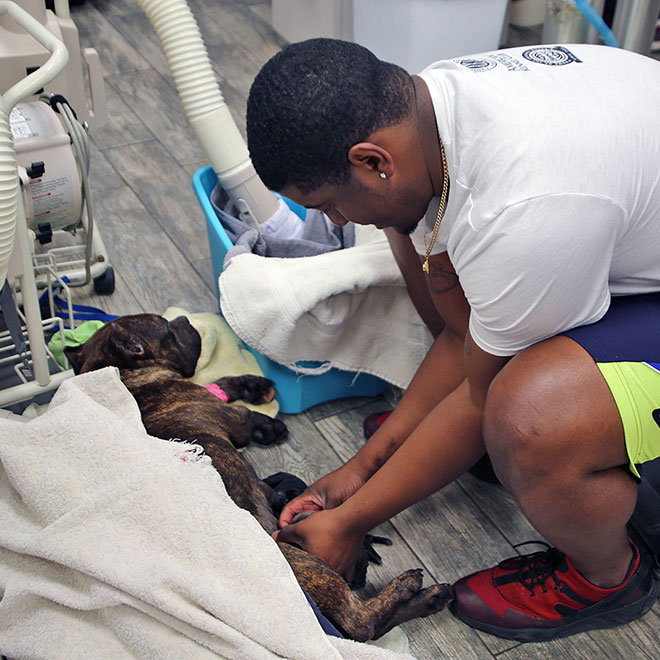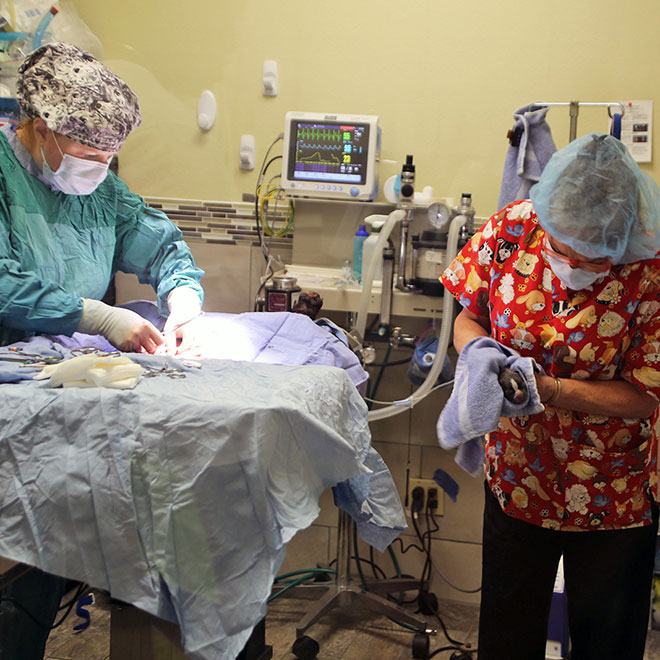Labor and Delivery and C-Section
Labor And Delivery:
Prior To Labor:
Several days before delivery, her vulva will enlarge, the tail head may become prominent, and watery milk may be present. Bitches with large amounts of hair on the abdomen should be shaved to assist the pups in nursing. Twenty-four hours prior to delivery, she may nest, stop eating and may vomit. Eight to 12 hours before delivery, the rectal temperature may drop by 2 to 3 degrees, to below 100 degrees, then rises back to 102 degrees as whelping approaches. At this time, she should be housed in a quiet warm room with suitable flooring or plastic sheeting and absorbent blankets. If not already done, her whelping box should be prepared. An inexpensive, easy to clean whelping box can be made from a child’s round swimming pool lined with towels, blankets, or a fitted carpet to improve footing for the pups to aid in their development.
Labor:
As with all mammals, there are 3 stages to delivery. The first consists of mild uterine contractions, and may last 6 to 12 hours, during which milk is present and the bitch is restless. At this point, you may notice that she passes a plug of mucus, called the cervical plug. The second stage is true labor (abdominal and uterine contractions) and delivery. In hard labor, the bitch will visibly strain and groan – she may lay down or stand.

Delivery:
In the uterus, each pup is surrounded by fetal membranes known as allantoic and amniotic membranes, their associated fluids, and a placenta. Delivery is preceded by passage of dark amber allantoic fluids. The amniotic sac passes into the cervix and anterior pelvis, resulting in abdominal straining and panting. Next, the perineum (skin around the vulva) distends as the amnion and pup is delivered. The first fetus should be delivered within 2 to 3 hours after the beginning of the start of hard labor. As long as the bitch’s vaginal discharge is clear and she is not in hard labor, she should not be disturbed. Puppies can live in the uterus for up to 24 hours after labor starts. Dogs in labor for 3 hours without delivery of the first pup should be examined for evidence of complications.
If you are comfortable with this, you may don a glove and do a vaginal examination to assess position of the puppy. If there is a puppy in the pelvic canal, you can help her by massaging the roof of the vagina (called feathering). You may be able to feel the pup’s head or legs and assist the bitch by pulling the puppy out and down (toward the bitch’s feet). Labor should be progressive and productive. If you are uninterested in intervening yourself, the bitch is weak and seems to you to be in danger, or you unable to assess the situation, this is the time to contact a veterinarian for assistance.
Subsequent pups should be delivered within 45 to 60 minutes of hard labor. Often the first 2 pups are born close together, and then a pause of up to several hours can occur. As long as the bitch is not in hard labor, or there is not excessive blood or green color to the discharge, there is no need to intervene. (Green color is normal after 1 or more pups have been delivered as this signifies placental separation). Frequently, the first and last pups are the largest, due to position in the uterus and optimum nutrition. It is not abnormal for pups to be born tail first (up to 40%). As long as the delivery is short, the pup should survive. Regardless of presentation, if the delivery is slow or difficult, the bitch can be assisted by gently grasping the pup with a towel or gauze and pulling downward between her rear legs.
The third and final stage of labor is the delivery of the placentae, which frequently occurs with each delivery. The amniotic sac is may be intact and the umbilical cord is unbroken. The bitch will normally remove the amnion and chew through the cord after each birth, then lick the pup to stimulate breathing. Do not interfere unless she is not interested, too aggressive or too weak. Try to account for one placenta per pup and allow her to eat only a few. Too many may cause stomach upset.
If the bitch fails to clean up the pup within 30 to 60 seconds of birth, you may need to intervene. This is best accomplished by tearing the sac off the face with a terry towel and rubbing the pup vigorously. A bulb syringe or DeeLee mucus trap can be used to suction excess fluids from the back of the pup’s throat. (Never swing the pups as this causes brain damage.) The pup can be held at a 45 degree angle with the head down to allow drainage of fluids from the airways if necessary.
If the pup does not start to breathe promptly, an acupuncture point (25 gauge needle inserted in the center of the upper lip, below the nostrils, insert to bone and rotate). This can be used to stimulate the first breath. If the puppy is weak and/or slow to come around, a drop of honey or Karo syrup on to the pups tongue can be used as a quick energy source. Mouth to-mouth and chest compressions can be attempted if the pup fails to respond to the above measures.
If the umbilical cord tears too short and bleeds, immediately clamp the cord and tie dental floss or thread around it to control blood loss.
Whelping is best accomplished at home and without intervention if possible. Disrupting the bitch can stop or delay delivery of the pups. Occasional walking to allow the bitch to urinate may assist with delivery. Be sure to accompany her and take along a towel (and flashlight if in the dark), just in case she delivers a pup while outside. Allowing pups to nurse between deliveries will aid in uterine contractions. Ice cream (for calcium and energy) can be fed to her (and you) throughout labor to aid in keeping her contractions strong and effective. If indicated, oxytocin use MUST be done very conservatively to avoid endangering the health of the bitch and puppies. Only very small doses, if any, should be administered without veterinary or Whelpwise® oversight and should NEVER exceed 2 injections. The more oxytocin most experienced breeder-veterinarians use, the more respect they have for it’s misuse.
Uterine Contraction Monitoring:
The WhelpwiseTM uterine contraction monitor (tocodynomometer) can be used to monitor pre-labor and labor and allow for early intervention if premature delivery or dystocia is diagnosed. As in human obstetrics, insightful monitoring of labor can significantly improve neonatal survival. The equipment for this service needs to be ordered in advance. They may be reached at 1-888-281-4867.
The fetal Doppler included can be utilized to assess fetal heartbeats and detect fetal distress.
Dytsocia:
There are 2 basic causes for dystocia or difficulties with deliveries: those caused by the bitch and those caused by the pups. Maternal causes included obesity; voluntary inhibition if interrupted or overly sensitive; abnormally small litters (1-2 pups); exhaustion; or small pelvic or vaginal diameter. Fetal causes are large head, malposition or malpresentation, large size, other structural defects, and 2 pups being delivered simultaneously. To help alleviate exhaustion in the bitch you may wish to offer vanilla ice cream to provide energy, fluids and calcium without causing vomiting.
Under some circumstances, the bitch will need assistance and should be taken to the veterinarian. Corrections of dystocia (performed by your veterinarian) include manipulation and traction on the pup, episiotomy, drug therapy (oxytocin, calcium and glucose) and Caesarian section. Each case must be considered and treated individually.

Cesarian Section (C-section):
At times, a c-section may be scheduled prior to the onset of labor. These reasons include small litters of 1-2 pups, larger litters of over 10 pups, or a breed at risk. On occasion, surgical intervention may be necessary to save the bitch and/or puppies. DO NOT DELAY HERE.
Any bitch that is too weak to stand, has an unexplained discharge from her eyes, unrelenting vomiting, has severe abdominal pain, is greater than 68 days postovulation, has a history of dystocia unrelated to fetal malposition, is having severe tremors, has green vaginal discharge without a pup delivered, has signs of fetal distress, has failed to respond to oxytocin, has weak contractions, has had her temp rise without labor starting, or is in hard labor 2 hours without presenting a pup needs immediate veterinary attention.
Done prior to the bitch and puppies developing extreme distress and done well by an experienced team of veterinarians and veterinary staff, C-sections can be highly successful, often producing 100% puppy survival rates. This is done with general anesthesia using PropofolR for induction followed by isoflurane or sevoflurane. The bitch is monitored during anesthesia with a pulse oximeter and is given IV fluids. A spay should only be performed at the c-section under extraordinary circumstances due to the associated risks. The puppies are rapidly removed from the uterus and revived. As soon as the puppies and bitch are medically stable, they are sent home in your care.
Thanks to Dr. Marty Greer for sharing this valuable content from her Breeder’s Library
Her book “Canine Reproduction & Neonatology” is invaluable to breeders and is available on Amazon.


 Tap to Call Now
Tap to Call Now